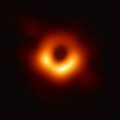| Quasar | Date | Distance | Notes |
|---|
| UHZ1 | 2023– | z = 10.2 | Current distance record holder [104] [70] |
| QSO J0313−1806 | 2021–2023 | z = 7.64 | [81] [104] |
| ULAS J1342+0928 | 2017–2021 | z = 7.54 | [105] |
| ULAS J1120+0641 | 2011–2017 | z = 7.085 | Not the most distant object when discovered. First quasar with z > 7. [84] |
CFHQS J2329-0301
(CFHQS J232908-030158) | 2007–2011 | z = 6.43 | Not the most distant object when discovered. It did not exceed IOK-1 (z = 6.96), which was discovered in 2006. [88] [89] [90] [91] [106] [107] [108] |
SDSS J114816.64+525150.3
(SDSS J1148+5251) | 2003–2007 | z = 6.419 | Not the most distant object when discovered. It did not exceed HCM 6A galaxy lensed by Abell 370 at z = 6.56, discovered in 2002. Also discovered around the time of discovery was a new most distant galaxy, SDF J132418.3+271455 at z = 6.58. [92] [93] [94] [91] [106] [109] [110] [111] [112] [113] |
SDSS J1030+0524
(SDSSp J103027.10+052455.0) | 2001–2003 | z = 6.28 | Most distant object when discovered. First object with z > 6. [97] [95] [98] [99] [101] [102] |
SDSS 1044-0125
(SDSSp J104433.04-012502.2) | 2000–2001 | z = 5.82 | Most distant object when discovered. It exceeded galaxy SSA22-HCM1 (z = 5.74; discovered in 1999) as the most distant object. [114] [115] [101] [102] [106] [116] [117] |
RD300
(RD J030117+002025) | 2000 | z = 5.50 | Not the most distant object when discovered. It did not surpass galaxy SSA22-HCM1 (z = 5.74; discovered in 1999). [118] [119] [115] [120] [106] |
SDSSp J120441.73−002149.6
(SDSS J1204-0021) | 2000 | z = 5.03 | Not the most distant object when discovered. It did not surpass galaxy SSA22-HCM1 (z = 5.74; discovered in 1999). [120] [106] |
SDSSp J033829.31+002156.3
(QSO J0338+0021) | 1998–2000 | z = 5.00 | First quasar discovered with z > 5. Not the most distant object when discovered. It did not surpass galaxy BR1202-0725 LAE (z = 5.64; discovered earlier in 1998). [106] [114] [121] [122] [123] [124] [125] |
| PC 1247+3406 | 1991–1998 | z = 4.897 | Most distant object when discovered. [114] [126] [127] [128] [129] |
| PC 1158+4635 | 1989–1991 | z = 4.73 | Most distant object when discovered. [114] [129] [130] [131] [132] [133] |
| Q0051-279 | 1987–1989 | z = 4.43 | Most distant object when discovered. [134] [130] [133] [135] [136] [137] |
Q0000-26
(QSO B0000-26) | 1987 | z = 4.11 | Most distant object when discovered. [134] [130] [138] |
PC 0910+5625
(QSO B0910+5625) | 1987 | z = 4.04 | Most distant object when discovered; second quasar with z > 4. [114] [130] [139] [140] |
Q0046–293
(QSO J0048-2903) | 1987 | z = 4.01 | Most distant object when discovered; first quasar with z > 4. [134] [130] [139] [141] [142] |
Q1208+1011
(QSO B1208+1011) | 1986–1987 | z = 3.80 | Most distant object when discovered and a gravitationally-lensed double-image quasar. From the time of discovery to 1991, had the least angular separation between images, 0.45″. [139] [143] [144] |
PKS 2000-330
(QSO J2003-3251, Q2000-330) | 1982–1986 | z = 3.78 | Most distant object when discovered. [56] [139] [145] [146] |
OQ172
(QSO B1442+101) | 1974–1982 | z = 3.53 | Most distant object when discovered. [147] [148] [149] |
OH471
(QSO B0642+449) | 1973–1974 | z = 3.408 | Most distant object when discovered; first quasar with z > 3. Nicknamed "the blaze marking the edge of the universe". [147] [149] [150] [151] [152] |
| 4C 05.34 | 1970–1973 | z = 2.877 | Most distant object when discovered. The redshift was so much greater than the previous record that it was believed to be erroneous, or spurious. [56] [57] [149] [153] [154] |
5C 02.56
(7C 105517.75+495540.95) | 1968–1970 | z = 2.399 | Most distant object when discovered. [154] [155] [78] |
4C 25.05
(4C 25.5) | 1968 | z = 2.358 | Most distant object when discovered. [154] [78] [156] |
PKS 0237-23
(QSO B0237-2321) | 1967–1968 | z = 2.225 | Most distant object when discovered. [56] [156] [157] [158] [159] |
4C 12.39
(Q1116+12, PKS 1116+12) | 1966–1967 | z = 2.1291 | Most distant object when discovered. [78] [159] [160] [161] |
4C 01.02
(Q0106+01, PKS 0106+1) | 1965–1966 | z = 2.0990 | Most distant object when discovered. [78] [159] [160] [162] |
| 3C 9 | 1965 | z = 2.018 | Most distant object when discovered; first quasar with z > 2. [2] [58] [159] [163] [164] [165] |
| 3C 147 | 1964–1965 | z = 0.545 | First quasar to become the most distant object in the universe, beating radio galaxy 3C 295. [166] [167] [168] [169] |
| 3C 48 | 1963–1964 | z = 0.367 | Second quasar redshift measured. Redshift was discovered after publication of 3C273's results prompted researchers to re-examine spectroscopic data. Not the most distant object when discovered. The radio galaxy 3C 295 was found in 1960 with z = 0.461. [48] [56] [170] [171] [172] [76] [166] |
| 3C 273 | 1963 | z = 0.158 | First quasar redshift measured. Not the most distant object when discovered. The radio galaxy 3C 295 was found in 1960 with z = 0.461. [48] [76] [171] [172] [173] |
|

